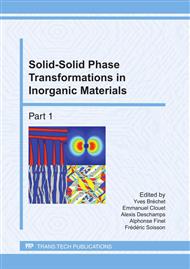p.881
p.887
p.893
p.899
p.905
p.911
p.916
p.922
p.931
The Structure and the Evolution of Titanate Nanobelts, Used as Seeds for the Nucleation of Hydroxyapatite at the Surface of Titanium Implants
Abstract:
The phase transformations due to a sequence of chemical treatments leading to the nucleation and biomimetic growth of hydroxyl carbonated apatite (HCA) at the surface of titanium implants were studied by scanning and transmission electron microscopy in cross-section. In the first step, an acid etching forms a rough titanium hydride layer which remains unchanged after subsequent treatments. In the second step, soaking in a NaOH solution induces the growth of nanobelt tangles of nanocrystallized, monoclinic sodium titanate. In the third step, soaking in a simulated body fluid transforms sodium titanate into calcium and phosphorus titanate, by ion exchange in the same monoclinic structure. Then HCA, of a hexagonal structure, grows and embodies the tangled structure showing a preferential direction growth along its “c”-axis, perpendicular to the substrate surface. The interfaces between the different layers seem to be strong enough to prevent interfacial decohesion. The role of the titanate phase in the nucleation of HCA is finally discussed.
Info:
Periodical:
Pages:
905-910
Citation:
Online since:
June 2011
Authors:
Price:
Сopyright:
© 2011 Trans Tech Publications Ltd. All Rights Reserved
Share:
Citation:


